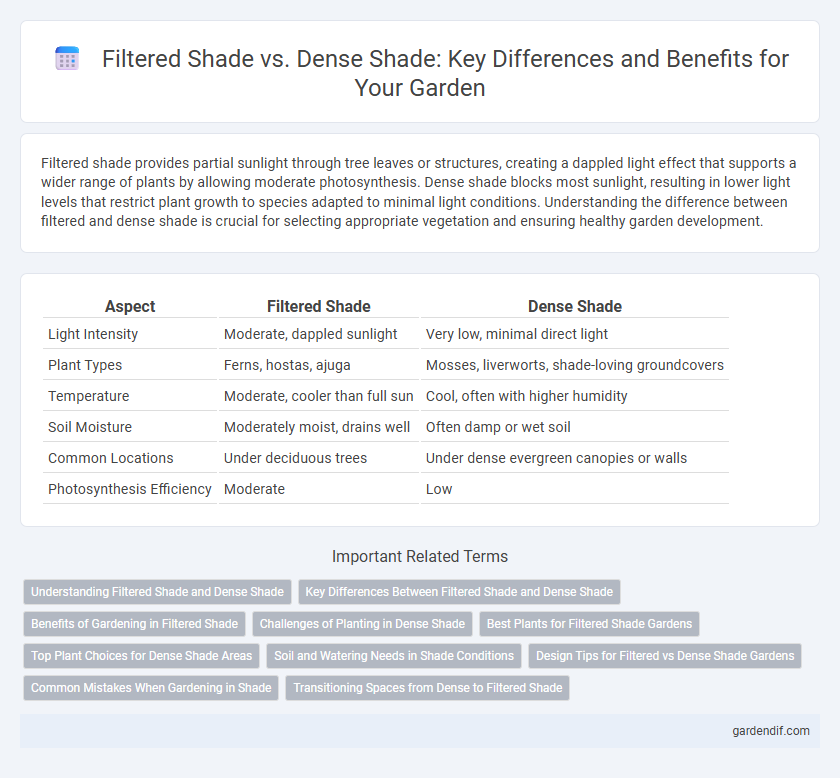
Filtered Shade vs Dense Shade Illustration
Filtered shade provides partial sunlight through tree leaves or structures, creating a dappled light effect that supports a wider range of plants by allowing moderate photosynthesis. Dense shade blocks most sunlight, resulting in lower light levels that restrict plant growth to species adapted to minimal light conditions. Understanding the difference between filtered and dense shade is crucial for selecting appropriate vegetation and ensuring healthy garden development.
Table of Comparison
| Aspect | Filtered Shade | Dense Shade |
|---|---|---|
| Light Intensity | Moderate, dappled sunlight | Very low, minimal direct light |
| Plant Types | Ferns, hostas, ajuga | Mosses, liverworts, shade-loving groundcovers |
| Temperature | Moderate, cooler than full sun | Cool, often with higher humidity |
| Soil Moisture | Moderately moist, drains well | Often damp or wet soil |
| Common Locations | Under deciduous trees | Under dense evergreen canopies or walls |
| Photosynthesis Efficiency | Moderate | Low |
Understanding Filtered Shade and Dense Shade
Filtered shade occurs when sunlight passes through tree leaves or other semi-transparent objects, creating a mix of light and shadow that supports the growth of shade-tolerant plants by providing intermittent sun exposure. Dense shade is characterized by a continuous blockage of direct sunlight, often found under thick canopies or structures, limiting photosynthesis and favoring plants adapted to low light conditions. Understanding the differences between filtered and dense shade helps gardeners select appropriate plants that thrive in varying light intensities, optimizing garden health and aesthetics.
Key Differences Between Filtered Shade and Dense Shade
Filtered shade allows partial sunlight to penetrate through tree leaves or light structures, promoting healthier plant growth and reducing moisture retention on surfaces. Dense shade, characterized by minimal to no direct sunlight, creates cooler and often damper conditions that can inhibit photosynthesis and increase the risk of mold or mildew development. Understanding these distinctions helps in selecting appropriate vegetation and landscaping strategies for different light environments.
Benefits of Gardening in Filtered Shade
Gardening in filtered shade provides optimal light conditions that balance sunlight and protection, promoting healthier plant growth and reducing water evaporation. Plants like ferns, hostas, and impatiens thrive in filtered shade, benefiting from moderated temperatures and reduced stress. This environment also minimizes pest-related damage and leaf scorch, enhancing overall garden vitality and aesthetics.
Challenges of Planting in Dense Shade
Planting in dense shade presents significant challenges due to limited sunlight penetration, which restricts photosynthesis and slows plant growth. Many common garden plants struggle to thrive under dense canopy cover, leading to sparse foliage and increased vulnerability to diseases. Selecting shade-tolerant species with adaptive traits is essential for success in these low-light conditions.
Best Plants for Filtered Shade Gardens
Filtered shade gardens receive dappled sunlight, ideal for plants like ferns, hostas, astilbes, and bleeding hearts that thrive with partial light. These plants require less direct sun than those suited for dense shade but benefit from bright, indirect light to encourage vibrant foliage and blooms. Selecting species adapted to filtered shade ensures healthier growth, reduced leaf scorch, and enhanced garden aesthetics.
Top Plant Choices for Dense Shade Areas
Hostas, ferns, and astilbes are top plant choices for dense shade areas due to their exceptional ability to thrive with minimal sunlight. These plants exhibit robust foliage and vibrant textures that enhance garden aesthetics while requiring low light conditions. Selecting species adapted to dense shade ensures healthy growth and reduced maintenance in shaded garden spots.
Soil and Watering Needs in Shade Conditions
Filtered shade offers moderate sunlight penetration, promoting balanced soil moisture and reducing frequent watering requirements compared to dense shade. Dense shade creates cooler, moister soil conditions but often retains excess moisture, increasing the risk of root rot and necessitating well-draining soil to prevent waterlogging. Optimal watering in filtered shade supports healthy plant growth by maintaining consistent soil hydration, while dense shade demands careful monitoring to avoid overwatering and soil saturation.
Design Tips for Filtered vs Dense Shade Gardens
Filtered shade gardens benefit from incorporating plants that thrive in partial sunlight, such as ferns, hostas, and astilbes, which create a light, airy atmosphere with varied textures. Dense shade gardens require shade-tolerant plants like Japanese forest grass, ivy, and mahonia, emphasizing foliage color and structure to compensate for limited sunlight. Using layered planting techniques and selecting plants according to specific light availability ensures optimal growth and aesthetic appeal in both filtered and dense shade environments.
Common Mistakes When Gardening in Shade
Many gardeners mistakenly treat filtered shade and dense shade as interchangeable, leading to plant selections that fail to thrive. Filtered shade allows occasional sunlight through tree canopies, supporting a wider range of shade-tolerant species, whereas dense shade often results in limited light, requiring more specialized plants adapted to low light conditions. Misjudging the intensity and duration of shade causes improper watering, fertilizing, and plant spacing, which can stunt growth or increase susceptibility to disease.
Transitioning Spaces from Dense to Filtered Shade
Transitioning spaces from dense to filtered shade enhances plant growth by increasing light availability while maintaining protection from harsh sunlight. Filtered shade allows dappled sunlight to penetrate, supporting a wider variety of shade-tolerant plants compared to the low light conditions of dense shade. This gradual shift creates microclimates that promote biodiversity and improve outdoor comfort by balancing light and temperature.
Filtered Shade vs Dense Shade Infographic

 gardendif.com
gardendif.com